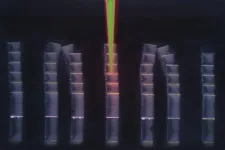Recent developments at MD Anderson include insights into the role of RNA-binding proteins in DNA damage repair, the functional role of a hidden microprotein in regulating colorectal cancer gene expression, immunotherapy combinations in gynecologic cancers, the benefits of preventive exercise in protecting against chronic pain after nerve injury, and using radiomic features to predict which patients with triple-negative breast cancer will benefit most from neoadjuvant therapy.
Study identifies RNA-binding proteins as novel drivers of DNA damage repair defects
Mutations in DNA repair genes are known drivers of hereditary cancers. However, only a small fraction of patients with hereditary breast or ovarian cancers have BRCA1/2 mutations, which are involved in homologous recombination (HR) DNA repair. Researchers led by Nidhi Sahni, Ph.D., calculated scores across tumors from The Cancer Genome Atlas to comprehensively identify tumors that were either positive or negative for HR defects. Around 75% of tumors with a positive HR score did not have defects in known HR genes, but the researchers identified nearly 100 candidate HR-related genes. They found that RNA-binding protein (RBP) genes were particularly enriched in genome-wide screens for cancer risk, highlighting their potential role as drivers of HR repair. Previous studies have linked RBPs to DNA damage repair, and this study provides further insights into specific RBPs and their role as novel drivers of HR deficiency, either directly or via regulating other HR repair genes. These findings have implications for screening, patient risk stratification and developing therapeutic strategies. Learn more in Cell Reports Medicine.
Hidden microprotein has functional role in colorectal cancer gene regulation
The human genome contains thousands of non-canonical open reading frames (ORFs) with the potential to encode functional proteins, including microproteins. These unannotated, cryptic proteins are not easily detected by conventional approaches and are considered part of the “dark” proteome. Previous studies have highlighted the tumor-suppressive function of some microproteins in colorectal cancer (CRC), but their role in cancer remains largely unknown. To provide further insights, researchers led by Yiwen Chen, Ph.D., used an integrated multiomic approach combining ribosome profiling, CRISPR/Cas9 screens and large-scale analysis of clinical data to identify non-canonical ORFs that may be functionally relevant in CRC. They identified a long noncoding RNA-encoded microprotein, SMIMP (SMC1A-interacting microprotein), that has tumor-promoting function in vivo and is associated with poor prognosis. They discovered that SMIMP plays an important role in gene regulation as part of the cohesin-mediated regulatory network. This study highlights the importance of investigating the functional roles of non-canonical ORFs to find potential new therapeutic targets. Learn more in Nature Structural & Molecular Biology.
Avelumab combinations do not improve responses in patients with advanced gynecologic malignancies
The immune checkpoint inhibitor avelumab has been approved for multiple cancer types, but has thus far had mixed results in gynecologic patients. A study led by Aung Naing, M.D., was designed to evaluate whether combining avelumab with a 4-1BB agonist (utomilumab), an OX40 agonist (PF-04518600) or radiotherapy would increase efficacy. Although the combinations proved to be safe, they did not produce significant responses in this heavily pretreated population. In 35 patients evaluated, the overall response rate (ORR) was 2.9% and the disease control rate (DCR) was 37.1%. No dose-limiting toxicities or treatment-related adverse events were observed. There was a notable result in the cervical cancer population where nine patients who received avelumab plus utomilumab had a DCR of 78%, which could warrant further study for these patients. Learn more in Cancer.
Preclinical study uncovers how exercise helps prevent peripheral neuropathy
Peripheral neuropathy, a complication of cancer treatment, can be debilitating for patients. Regular exercise prior to peripheral nerve injury provides protection from chronic neuropathic pain after injury, but the underlying mechanisms that condition nerves to reduce pain are poorly understood. Building upon previous studies that highlight mechanisms impacting peripheral nerve injury, researchers led by Peter Grace, Ph.D., examined the protective anatomical and biochemical effects of voluntary exercise prior to nerve injury and the resulting pain management. They showed that six weeks of voluntary wheel running in lab models prevented the formation of membrane attack complexes (MACs) and reduced myelin degradation at the nerve injury site. More specifically, the researchers identified increased expression of CD59, a MAC inhibitory protein with neuroprotective properties. The study shows the link between reduced pain by prior exercise with the inhibition of MAC and preservation of myelin at the nerve injury site. Learn more in Brain, Behavior, and Immunity.
Radiomic models help predict treatment response for triple-negative breast cancer
Patients with triple-negative breast cancer (TNBC) typically receive neoadjuvant (pre-surgical) systemic therapy (NAST) with chemotherapy and immunotherapy to help shrink their tumors and improve outcomes. However, only approximately 60% of patients achieve a pathologic complete response (pCR) to NAST, highlighting a need to predict which patients would benefit most from this therapy to avoid unnecessary toxicity. Researchers led by Jingfei Ma, Ph.D., and Gaiane Rauch, M.D., Ph.D., evaluated the use of radiomic features from dynamic contrast-enhanced magnetic resonance imaging (DCE-MRI) of the tumoral and peritumoral regions taken during multiple time points of NAST in 163 patients with TNBC. Seventy-eight (48%) patients achieved pCR. The researchers identified 46 radiomic features able to predict pCR with at least 70% accuracy, and 13 multivariate models were more than 75% accurate for early prediction of NAST response. The study highlights the use of radiomic features to help with risk stratification for patients with TNBC that are most likely to benefit from NAST. Learn more in Frontiers in Oncology.
In case you missed it
Read below to catch up on recent MD Anderson press releases.
MD Anderson announces Institute for Data Science in Oncology to advance mission to end cancer MD Anderson and Jazz Pharmaceuticals announce five-year collaboration to evaluate zanidatamab in HER2-expressing cancers MD Anderson Research Highlights: SITC 2023 Special Edition Read this press release in the MD Anderson Newsroom.
– 30 –
END



